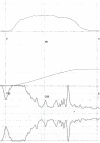Flowmetry/ pelvic floor electromyographic findings in patients with detrusor overactivity
- PMID: 26200545
- PMCID: PMC4752145
- DOI: 10.1590/S1677-5538.IBJU.2014.0204
Flowmetry/ pelvic floor electromyographic findings in patients with detrusor overactivity
Abstract
To evaluate different flowmetry/EMG patterns in patients with proven detrusor overactivity (DO) and compare them with that of a group of patients with lower urinary tract symptoms (LUTS) but without DO.
Materials and methods: We retrospectively evaluated the records of 100 patients with frequent urinary tract infection or any kind of storage or voiding symptoms that had undergone urodynamic testing: 50 cases with proven DO on cystometry who had a good quality flowmetry/EMG and 50 patients without DO. EMG lag time (the time distance between pelvic floor EMG inactivation and the start of urine flow) and different flow curve pattern were recorded and compared.
Results: The age and gender distribution were not statistically significant between the two groups. A negative lag time (≤ 0 sec) and an obstructive pattern were the only parameters that were more commonly seen in the DO group. Sensitivity, specificity, positive predictive value (PPV) and negative predictive value (NPV) of a lag times <2 sec for diagnosing DO were 70%, 96%, 96% and 72%, respectively. For a negative lag time, they were 52%, 100%, 100% and 63%, respectively.
Conclusions: A lag time <2 sec is a useful flowmetric finding that effectively rules out patients with LUTS that do not have DO (specificity and PPV=96%). With the cutoff of zero or less, specificity and PPV will be 100%. It has lower sensitivity and NPV, however, and is not measurable in a considerable population of patients with DO that have concomitant DV.
Figures
Similar articles
-
Short pelvic floor electromyographic lag time: a novel noninvasive approach to document detrusor overactivity in children with lower urinary tract symptoms.J Urol. 2013 Jun;189(6):2282-6. doi: 10.1016/j.juro.2013.01.011. Epub 2013 Jan 9. J Urol. 2013. PMID: 23313197
-
Short pelvic floor EMG lag time II: use in management and follow-up of children treated for detrusor overactivity.J Pediatr Urol. 2014 Apr;10(2):255-61. doi: 10.1016/j.jpurol.2013.10.013. Epub 2013 Nov 7. J Pediatr Urol. 2014. PMID: 24291249
-
Videourodynamic analysis of the urethral sphincter overactivity and the poor relaxing pelvic floor muscles in women with voiding dysfunction.Neurourol Urodyn. 2017 Nov;36(8):2169-2175. doi: 10.1002/nau.23263. Epub 2017 Mar 27. Neurourol Urodyn. 2017. PMID: 28346720
-
Urodynamic evaluation of the bladder and pelvic floor.Gastroenterol Clin North Am. 2008 Sep;37(3):539-52, vii. doi: 10.1016/j.gtc.2008.06.006. Gastroenterol Clin North Am. 2008. PMID: 18793995 Review.
-
Is coexistent overactive-underactive bladder (with or without detrusor overactivity and underactivity) a real clinical syndrome? ICI-RS 2019.Neurourol Urodyn. 2020 Jul;39 Suppl 3:S50-S59. doi: 10.1002/nau.24311. Epub 2020 Feb 7. Neurourol Urodyn. 2020. PMID: 32032454 Review.
References
-
- Franco I. Pediatric overactive bladder syndrome: pathophysiology and management. Paediatr Drugs. 2007;9:379–390. - PubMed
-
- Nevéus T, Sillén U. Lower urinary tract function in childhood; normal development and common functional disturbances. Acta Physiol (Oxf) 2013;207:85–92. - PubMed
-
- Glassberg KI, Combs AJ, Horowitz M. Nonneurogenic voiding disorders in children and adolescents: clinical and videourodynamic findings in 4 specific conditions. J Urol. 2010;184:2123–2127. - PubMed
-
- Van Batavia JP, Combs AJ, Hyun G, Bayer A, Medina Kreppein D, Schlussel RN, et al. Simplifying the diagnosis of 4 common voiding conditions using uroflow/ electromyography, electromyography lag time and voiding history. J Urol. 2011;186:1721–1726. - PubMed
-
- Combs AJ, Van Batavia JP, Horowitz M, Glassberg KI. Short pelvic floor electromyographic lag time: a novel noninvasive approach to document detrusor overactivity in children with lower urinary tract symptoms. J Urol. 2013;189:2282–2286. - PubMed
Publication types
MeSH terms
LinkOut - more resources
Full Text Sources
Medical


